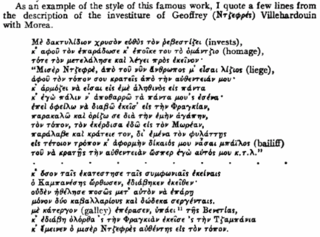 W
WAnonymi Barensis Chronicon is a medieval Italian annalistic chronicle.
 W
WThe Chronicle of 754 is a Latin-language history in 95 sections, written by an anonymous Mozarab (Christian) chronicler in Al-Andalus. The Chronicle contains the earliest known reference in a Latin text to "Europeans" (europenses), whom it describes as having defeated the Saracens at the battle of Tours in 732.
 W
WThe Cronaca fiorentina di Marchionne di Coppo Stefani written by Baldassarre Bonaiuti is considered today as one of the best works written on the Black Death in Florence in the year 1348. It is the only known literary work by Bonaiuti. It was written in vulgar Latin. There is no information as to when he may have started his work, but he devoted much time on it in his retirement from about 1378 until his death, a period of seven years.
 W
WThe Historia Sicula is a chronicle and work written in Latin Medieval prose about the story of the Kingdom of Sicily and Kingdom of Naples, taking place between the years 1250 and 1293. The text was edited by Bartholomaeus of Neocastro. The work is important as it is the best known account of the Sicilian Vespers.
 W
WLu rebellamentu di Sichilia, fully Cronica di lu rebellamentu di Sichilia contra re Carlu, is a Sicilian historical chronicle of the War of the Vespers written around 1290. The anonymous Rebellamentu, probably written at Messina, was ascribed to Atanasiu di Iaci by Pasquale Castorina in 1883. Though the Rebellamentu sometimes adds valuable details to the history of the Vespers, it is frequently untrustworthy. Its monastic provenance is evident in its moralising tone. The antiquity of its language has placed its authenticity beyond doubt, despite its lack of an early manuscript tradition. This has not prevented speculation that it was written contemporarily with events: one verb in one manuscript is found in the first-person present; this may represent the author inadvertently stepping out of his usual frame of reference, or merely an error in that manuscript.
 W
WThe Chronicle of the Morea is a long 14th-century history text, of which four versions are extant: in French, Greek, Italian and Aragonese. More than 9,000 lines long, the Chronicle narrates events of the Franks' establishment of feudalism in mainland Greece. West European Crusaders settled in the Peloponnese following the Fourth Crusade. The period covered in the Chronicle was 1204 to 1292. It gives significant details on the civic organization of the Principality of Achaia.
 W
WThe Nuova Cronica or New Chronicles is a 14th-century history of Florence created in a year-by-year linear format and written by the Italian banker and official Giovanni Villani. The idea came to him after attending the first Jubilee in the city of Rome, in 1300, where he realized that Rome's many historical achievements were well-known, and he desired to lay out a history of the origins of his own city of Florence. In his Cronica, Villani described in detail the many building projects of the city, statistical information on population, ordinances, commerce and trade, education, and religious facilities. He also described several disasters such as famines, floods, fires, and the pandemic of the Black Death in 1348, which would take his own life. Villani's work on the Cronica was continued by his brother and nephew after his death. It has been described as the first introduction of statistics as a positive element in history.